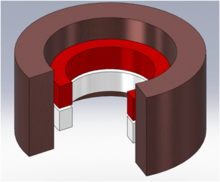Electrodynamic bearing


Electrodynamic bearings (EDBs) are contactless electrodynamic suspensions of rotating shafts. Relative to active magnetic bearings (AMB) the passive nature of the levitation achieved by EDBs allows a simpler, more reliable and cheaper solution, opening the field of application to medium and large-scale production.[1][2][3]
The working principle is based on the induction of eddy currents in a rotating conductor. When an electrically conducting material is moving in a magnetic field, a current will be generated in the material that counters the change in the magnetic field (known as Lenz' Law). This generates a current that will result in a magnetic field that is oriented opposite to the one from the magnet. The electrically conducting material is thus acting as a magnetic mirror.[4][5][6][7][8][9][10][11][12][13]
Radial magnetic bearing
Avoiding eddy current losses
Before the mid 1990s the eddy currents damping was problematic, but eddy currents and associated power dissipation can be reduced to very low values. The principle of operation is as follows:
A bearing must (1) support a loading force (for example, the weight of a rotor) and (2) provide a force gradient (a restoring force) to hold the rotor in position. Permanent magnets can support weight (in a conventional way, without eddy currents), and without creating destabilizing force gradients, but the Earnshaw theorem precludes achieving stability by this means. Eddy currents can provide a stabilizing force gradient without applying a force at the operating position (for example, when a shaft is centered). Creating this force gradient does not require eddy currents (which are induced in proportion to shaft offset). In practice, eddy currents, and hence resistive losses, can be reduced to small values in normal operation. Dynamic bearings of this class, using permanent magnets and ordinary, resistive conductors, can support load and apply restoring force while dissipating little power (and in principle, none).
An improved design approach for bearings of this class was described and analyzed by Dr. Torbjörn Lembke[14] in his PhD thesis at the Royal Institute of Technology, KTH, in Stockholm, Sweden.[15]
Linear magnetic bearing
Linear dynamic magnetic bearings also exist. For example inductrack which uses halbach arrays and litz wire loops.
See also
- Electromagnetic suspension
- Electrodynamic wheel
- Magnetic bearing
- Spin-stabilized magnetic levitation
- Levitron
References
- ↑ Amati, N., Tonoli, A., Zenerino, E., Detoni, J. G., Impinna, F., "Design Methodology of Electrodynamic Bearings", XXXVIII Associazione Italiana per l'Analisi delle Solecitazioni, Convegno Nazionale, No. 109, 2009
- ↑ Filatov, A. V., Maslen, E. H., and Gillies, G. T., "A Method of Suspension of Rotating Bodies Using Electromagnetic Forces", Journal of Applied Physics, Vol. 91
- ↑ Filatov, A. V., Maslen, E. H., and Gillies, G. T., "Stability of an Electrodynamic Suspension" Journal of Applied Physics, Vol. 92 (2002), pp. 3345-3353.
- ↑ Basore P. A., "Passive Stabilization of Flywheel Magnetic Bearings," Master’s thesis, Massachusetts Institute of Technology (USA), 1980.
- ↑ Murakami C. and Satoh I., “Experiments of a Very Simple Radial-Passive Magnetic Bearing Based on Eddy Currents”, In Proceedings of the 7th International Symposium on Magnetic Bearings, March 2000.
- ↑ Bender D. and Post R. F., “Ambient Temperature Passive Magnetic Bearings for Flywheel Energy Storage Systems”, In Proceedings of the 7th International Symposium on Magnetic Bearings, March 2000.
- ↑ Moser R., Regamey Y. J., Sandtner J., and Bleuler H., “Passive Diamagnetic Levitation for Flywheels”, In Proceedings of the 8th International Symposium on Magnetic Bearings, 2002.
- ↑ Filatov A. V., McMullen P., Davey K., and Thompson R., “Flywheel Energy Storage System with Homopolar Electrodynamic Magnetic Bearing”, In Proceedings of the 10th International Symposium on Magnetic Bearings, 2006.
- ↑ Sandtner J. and Bleuler H., “Electrodynamic Passive Magnetic Bearings with Planar Halbach Arrays”, In Proceedings of the 9th International Symposium on Magnetic Bearings, August 2004.
- ↑ Sandtner J. and Bleuler H., “Passive Electrodynamic Magnetic Thrust Bearing Especially Designed for Constant Speed Applications ”, In Proceedings of the 10th International Symposium on Magnetic Bearings, August 2004.
- ↑ Amati N., De Lépine X., and Tonoli A., “Modeling of electrodynamic Bearings”, ASME Journal of Vibration and Acoustics, 130, 2008.
- ↑ Kluyskens V., Dehez B., “Dynamical electromechanical model for passive magnetic bearings”, IEEE Transactions on Magnetics, 43, pp 3287-3292, 2007.
- ↑ Kluyskens V., Dehez B., “Parameterized electromechanical model for magnetic bearings with induced currents”, Journal of System Design and Dynamics - Special Issue on the Eleventh International Symposium on Magnetic Bearings, 2009.
- ↑ T. Lembke
- ↑ "Design and Analysis of a Novel Low Loss Homopolar Electrodynamic Bearing." Lembke, Torbjörn. PhD Thesis. Stockholm: Universitetsservice US AB, 2005. Print. ISBN 91-7178-032-7